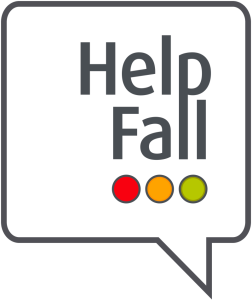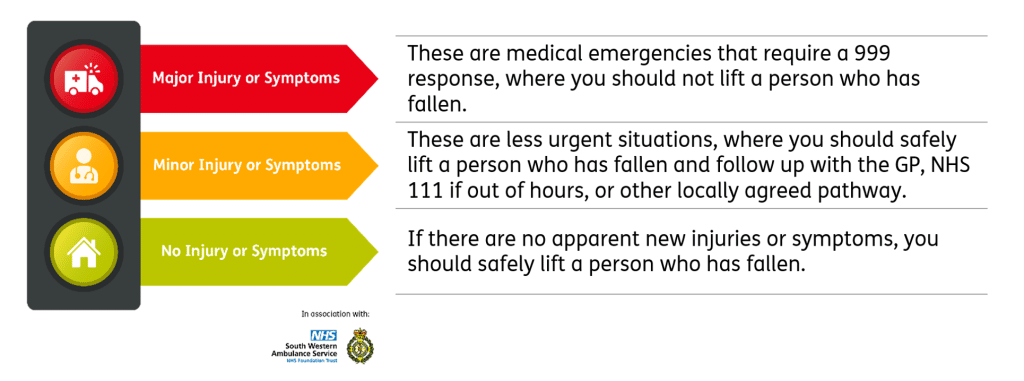How To Use HelpFall To Assess A Fallen Person For Injury
If you’re researching what the best post falls assessment tool for you is, chances are you’ll be asking questions about how the assessment process works, to decide if it’s relevant for your service.
In this article, I’ll be explaining exactly how the HelpFall Post Falls Decision Support Tool helps you assess a fallen person, and endeavour to give you a thorough understanding of what it does and doesn’t do.
What is HelpFall?HelpFall is the new standard in post-falls decision making, designed to support care staff in safely assessing a person who has fallen.
|
 |
Can HelpFall be used to assess anyone who has fallen?
HelpFall’s content and guidance is designed with a specific target audience in mind: elderly fallers in settings like care homes and domiciliary care.
So if your use case is something different, such as inpatient falls in a hospital, HelpFall probably isn’t going to be 100% suitable because the assessment process and care pathways will likely be different.
So, what’s the core purpose of HelpFall?
Put simply, it’s to support non-clinical care workers to make an informed decision about whether a service user who has fallen is safe to be lifted from the floor. The intended users are staff working in care homes, domiciliary care agencies and community response teams.
Where does HelpFall come from?
Building on the work of the South Western Ambulance Service, who produced a paper-based Post Falls Guidance Pack for care providers, Felgains brought together a group of expert clinicians to develop a new digital tool, drawing on guidance from NICE and the National Patient Safety Agency.
OK, so how does it actually work?
All you have to do to access the HelpFall Web App is scan a QR code with a tablet or smartphone camera. You’ll be asked to enter your access code and you’re ready to go.
HelpFall takes you through 10 questions and uses traffic lights to categorise the fall into major, minor and no injury/symptoms, then recommends appropriate actions and care pathways based on your answers.

The assessment starts by asking you to check for common signs of major injury or symptoms, from the very basics of first aid i.e., are they conscious and breathing normally? to more specific red flags like signs of hip fracture and severe head injury.
While these account for a minority of falls, starting here gives you the reassurance of ruling out the most severe consequences of a fall first and gets you on to 999 quickly should you need to.
Speaking of assurance, the tool is designed to build assurance at each step. We understand that doing a post falls assessment can feel quite daunting and you want to be absolutely sure you’re doing the right thing. That’s why we’ve included things like ‘HelpFall Hints’ which give additional context to the questions to guide your decision-making. If you do observe any new injuries or symptoms, HelpFall suggests specific actions that should be taken in each situation.
Once you’ve ruled out new major injuries or symptoms, you’ll be asked to check for any common signs of a minor (or less urgent) injury or symptoms. This covers everything from small cuts and grazes to arm injuries.
Biased I know, but we think this is one of the big advantages of HelpFall. Let’s take the example of a service user who has fallen and sustained a broken wrist. Traditional tools typically give you one option: call 999 for an ambulance. But in today’s world, that means leaving the person on the floor while you wait for an ambulance is very likely to result in a ‘long lie’.
Considering that harm and injury can be caused by a ‘long lie’ of just one hour, and current response times for a non-urgent call can be several hours, you can see why this is a real problem. How many people who have fallen end up being admitted to hospital because of complications from a long lie, blocking bed spaces and putting them at high risk of deconditioning (which increases the likelihood of future falls!)?
That’s why HelpFall will recommend lifting a service user who has sustained a broken wrist (if no other major injuries or symptoms are apparent) before making contact with urgent care. That’s because, with arm injuries, it’s highly unlikely you’ll cause further significant harm by safely lifting a person from the floor1. A service user may need to visit an emergency department, but if you can achieve this safely without a ‘long lie’, you’re improving care outcomes and patient experience.
Many less urgent injuries or symptoms can also be treated by community providers such as the new Urgent Community Response Services, so HelpFall encourages the use of these services where it’s an appropriate alternative to 999 or NHS 111.
Once you’ve completed the questions, you can request an automated report which gives you a record of your findings and actions taken. These can also be shared with a care home’s multidisciplinary team, for example. Having evidence of the process followed documented has proved very popular with care homes that have been fearful in the past of the possibility of any litigation.
What about data protection?
We can’t talk about collecting data and not mention data protection! To be totally frank, one of our biggest concerns when developing HelpFall was making sure we were permitted to collect and process personal health data in a way that a) gave the user a record of their assessment and b) could be anonymised, aggregated and analysed to pick out trends.
So we decided to get ahead of the curve by making HelpFall NHS DTAC ready. What’s that? I hear you say! Well, it’s a new and comprehensive set of standards covering data protection, cyber security and clinical safety that all digital health technologies should comply with to be used within NHS settings. For HelpFall, this meant things like appointing a Data Protection Officer, producing a Data Protection Impact Assessment and meeting NHS Data Security & Protection Toolkit standards.
Technical jargon aside, the bottom line is HelpFall is GDPR-compliant! However, if you’ve got specific questions or concerns, don’t hesitate to reach out to discuss.

Is there anything it doesn’t do?
Yes. For example, HelpFall doesn’t directly determine the cause of the fall. However, you are asked to consider and enter possible contributing factors at the report stage. This could be anything from simple loss of balance or unsuitable footwear, but it’s up to you to keep an eye out for other health factors that might be at play, such as urinary tract infections, worsening of long-term conditions like diabetes or changes in medication.
And while it covers the most common injuries and symptoms, it’s not possible to cover every possible post falls scenario. So although it’s based on solid evidence and expertise from our clinical team, NICE guidance and use in care homes & domiciliary care settings, you should be mindful that if you should encounter an unusual situation, advice from a senior clinician should be sought. This might occur where a service user has particularly complex co-morbidities.
Can HelpFall be used to assess a fallen person if they have communication difficulties?
We must also point out that it is sometimes difficult to assess whether a service user has injuries if they have communication difficulties. The good news is most of the questions in the HelpFall post falls tool can be answered by simply observing the person who has fallen.
You can also use tools such as the Abbey Pain Scale in conjunction with HelpFall to help you assess whether service users who cannot verbalise are in pain. You can find the Abbey Pain Scale here.
What about unwitnessed falls?
HelpFall is designed to help you check for common signs of new injury or symptoms regardless of whether the fall was witnessed or unwitnessed. However, if you have any concerns, you should contact a senior clinician for advice.
This may have been a long read, but I hope you now feel well-informed about the way HelpFall supports you to assess a person who has fallen and make an informed decision to lift, or not – resulting in fewer long lies!
As ever, if you’ve got any questions we haven’t yet answered, you can get in touch at [email protected] or 01473 741144, or by filling in the form at the bottom of this page.
Citations
[1] https://www.youtube.com/watch?v=E1tg3Q4z5Qw&t=1521s
Related articles
How Much Does The HelpFall Post Falls Decision Support Tool Cost? (Updated For 2023)
How Much Do Falls Cost The NHS?
How Do You Lift an Elderly Person Who Has Fallen? (With Or Without Equipment)
Get in touch
Got a question or want to send us a message? Let’s talk.